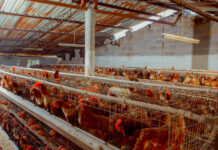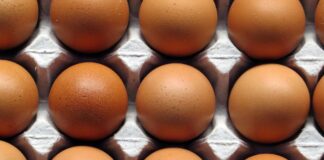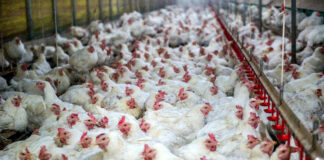
This study suggests that there is interference between the digestion of starch and protein and/or absorption of glucose and amino acids. Paradoxically, the low-protein diet significantly increased free concentrations of lysine, methionine, threonine and valine in plasma taken from the anterior mesenteric vein.
A standard diet (219 g/kg protein, 269 g/kg starch) and a low-protein diet (190 g/kg protein, 439 g/kg starch) were offered to eight replicate cages of male Ross 308 chicks from 7 to 28 days post-hatch. Maize grain was decreased and maize starch increased to reduce dietary protein and evaluate the impact of starch in this context. The transition to the low-protein diet significantly increased ileal starch digestibility by 10.8% but decreased digestibilities of essential amino acids and protein (N) by 6.1%.
Introduction
 Low-protein diets for broiler chickens axiomatically contain high inclusions of supplemental amino acids and have the potential to generate economic, environmental and bird welfare advantages. Low-protein diets are usually formulated by reducing soybean meal inclusions and increasing inclusions of a range of supplemental amino acids. An alternative approach was adopted in the present study where dietary protein levels were reduced by the partial replacement of maize grain with maize starch.
Low-protein diets for broiler chickens axiomatically contain high inclusions of supplemental amino acids and have the potential to generate economic, environmental and bird welfare advantages. Low-protein diets are usually formulated by reducing soybean meal inclusions and increasing inclusions of a range of supplemental amino acids. An alternative approach was adopted in the present study where dietary protein levels were reduced by the partial replacement of maize grain with maize starch.
The low-protein diet contained relatively high dietary starch levels and was supplemented with amino acids. The rationale for this approach was to evaluate the impact of readily digested maize starch on the digestive dynamics of supplemental and protein-bound amino acids. In the original study a standard positive control diet (1A) was compared with five low-protein diets; however, in this presentation 1A is directly compared with low-protein diet 3C as all five low-protein diets generated very similar outcomes.
Methodology
The composition and nutrient specifications of the two experimental diets are shown in Table 1. Maize was decreased (465 to 98 g/kg) and maize starch increased (0 to 483 g/kg) in the transition from diet 1A to 3C, additional supplemental lysine, methionine and threonine were included in diet 3C to which isoleucine, valine and arginine were also added. As a consequence, diet 1A contained 219 g/kg protein and 269 g/kg starch (analysed) while diet 3C contained 190 g/kg protein and 439 g/ kg starch. The experimental diets were steampelleted at a conditioning temperature of 80 °C and crumbled.
Both dietary treatments were offered to eight replicate cages (6 birds per cage) of male Ross 308 chicks from 7 to 28 days post-hatch when growth performance was monitored. At 25 days post-hatch, total excreta was collected over a 48 hour period to determine parameters of nutrient utilization (AME, N retention). At 28 days birds were euthanised to take digesta from the distal ileum to determine digestibility coefficients of starch, protein (N) and essential amino acids. Gizzard pH and relative pancreas weights were determined and blood samples taken from the anterior mesenteric vein to determine concentrations of free essential amino acids in the portal circulation.
Results
Dietary treatment effects on growth performance, nutrient utilization, ileal digestibility coefficients of starch, protein (N), essential amino acids and their concentrations in plasma from the portal circulation are shown in Table 2. The low–protein diet significantly increased feed intakes by 8.0%, tended to compromise FCR by 5.3% (P=0.079), significantly enhanced AME by 0.68, N retention by 6.4 percentage units and also ME:GE ratios and AMEn (data not shown). The low-protein diet significantly elevated pH, depressed relative pancreas weights, increased ileal starch digestibility by 10.8% (0.967 versus 0.873; P<0.001) but decreased protein digestibility by 6.1% (0.723 versus 0.770; P<0.005). The transition to the low-protein diet significantly compromised the digestibility of all nine amino acids which ranged from reductions of 1.74% (methionine; P=0.023) to 8.34% (leucine; P<0.001). Somewhat paradoxically, the low-protein diet significantly increased free concentrations of lysine by 94% (76.8 versus 39.5 mg/mL; P=0.001), methionine by 69% (21.6 versus 12.8 mg/mL; P=0.003), threonine by 61% (82.0 versus 51.0 mg/mL; P=0.003), and valine by 37% (41.8 versus 30.6 mg/mL; P=0.021) in the portal circulation. Pearson correlations between apparent digestibility coefficients of starch and essential amino acids in three small intestinal segments are shown in Table 3. Nine essential amino acids were assessed; starch digestibility was negatively correlated with the digestibility of seven amino acids in the proximal jejunum, nine in the proximal ileum and eight in the distal ileum to significant extents.
Discussion
The dietary transition was accomplished by substituting maize grain with maize starch which modified the dietary compositions considerably. The resultant increased gizzard pH and decreased pancreas weights with the low-protein diets are indicative of depressed gizzard functionality. The large proportion of negative correlations between starch and amino acid digestibility coefficients in the three caudal small intestinal segments observed is consistent with the concept advanced by Vinardell (1990) that there is mutual inhibition between sugars and amino acids for intestinal absorption.
There is the possibility that glucose and amino acids effectively compete for intestinal uptakes when co-absorbed with sodium (Na) via their respective Na+-dependent transport systems. This is predominantly SGLT-1 for glucose; however, several Na+-dependent (and independent) transport systems are involved with the absorption of amino acids. In the present study, arginine, isoleucine and phenylalanine appeared to be the amino acids most likely to have their digestibility compromised by a large dietary concentration of readily digestible starch and competition with glucose for intestinal uptakes.
Intestinal uptakes of nutrients are probably a critical limiting factor on broiler performance. However, absorbed nutrients must transit across the gut mucosa to enter the portal circulation and it has been demonstrated that glucose and amino acids, especially glutamate and glutamine, are catabolized in avian enterocytes to meet the copious energy requirements of the digestive tract. A curious outcome was that the transition to the low protein diets significantly decreased ileal digestibilities of isoleucine, lysine, methionine, threonine, and valine but, enigmatically, significantly increased concentrations of lysine, methionine, threonine, and valine in plasma taken from the anterior mesenteric vein and numerically increased isoleucine. It is probably relevant that the five amino acids mentioned were the only ones added to diet 3C as supplemental amino acids.
The proportions supplemental amino acids represented of dietary totals were in the order of 12, 19, 67, 23 and 37% for isoleucine, lysine, methionine, threonine, and valine, respectively. Thus this outcome is at least consistent with the possibility that supplemental amino acids are more likely to gain entry into the portal circulation than their protein-bound counterparts. If so, there are probably two responsible factors. Supplemental amino acids are completely bioavailable do not require digestion and rapidly appear in the portal circulation. Supplemental amino acids are absorbed in anterior segments of the small intestine where more glucose is present as an alternative (and more efficient) energy substrate for catabolism in the gut mucosa. Therefore, supplemental amino acids may be more likely to be spared from catabolism in the gut mucosa than their protein-bound counterparts.
Source: Australian Poultry Science Symposium 2018

















